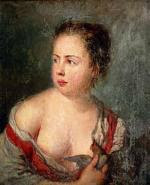Monday, February 28, 2011 - 
 No comments
No comments

 No comments
No comments
Polish newspaper Rzeczpospolita reports World War II looted painting "Girl with a Dove" by Antoine Pesne has been located in Moscow
 by Catherine Schofield Sezgin, editor
by Catherine Schofield Sezgin, editorJournalist Luke Zalesiński in the Polish daily newspaper, Rzeczpospolita, reports online today here that the National Museum in Poznan has found one of it's World War II looted paintings in Moscow but may have to buy it back before it is returned to Poland. (You can also find another blog, Poland.pl, that relayed this information in English here).
Antoine Pesne, a court painter of King Frederick II of Prussia, created "Girl with a Dove" in 1754. The National Museum of Poznan purchased it from a private collector. In 1943, the Germans ordered the evacuation of the museum and sent art to eastern Germany where they were later taken by the Red Army. Only a portion of the collection was returned after the war.
Piotr Michalowski, director of the National Museum in Poznan, has identified the painting with photographs made before the war and reports that the painting has suffered some damage. Negotiations by the Ministry of Culture for the return of the painting have been ongoing since last summer.
Polish museums and private collectors lost about 70 percent of material heritage such as paintings by Raphael, Brueghel, Van Dyck, Malczewski, Kossak, and Gierymski, according to the cultural ministry. "Today it is difficult to determine what proportion of stolen cultural property returned to the country as a result of post-war restitution share," according to article (as translated from Polish to English). The Ministry of Culture's stolen art database has 60,000 records, but "but often one entry refers to several items that were listed once under the same inventory number."
Poland's Ministry of Foreign Affairs, according to the article, has a team trying to recovery cultural property and searches major auction houses for images of stolen art. The article cites two examples: The National Museum in Warsaw recovered "Adrieana Brouwer's "The peasants in the tavern" when it was put up for sale at Christie's in London in the late 1990s, according to the article. By the time the museum identified the painting, it had been sold to a London art dealer who had sold it to someone in France. The London art dealer, Johnny van Haeften, repurchased the painting and returned it to Warsaw. Alexander Gierymski's painting, "Jewish and oranges", was found in a Germany auction house last year and negotiations are ongoing for its return.
"Good faith" laws protecting the purchasers of art from claims of stolen property in many countries create barriers for the return of looted art.
Photo: "Girl with a Dove" image from the National Museum of Poznan.


























